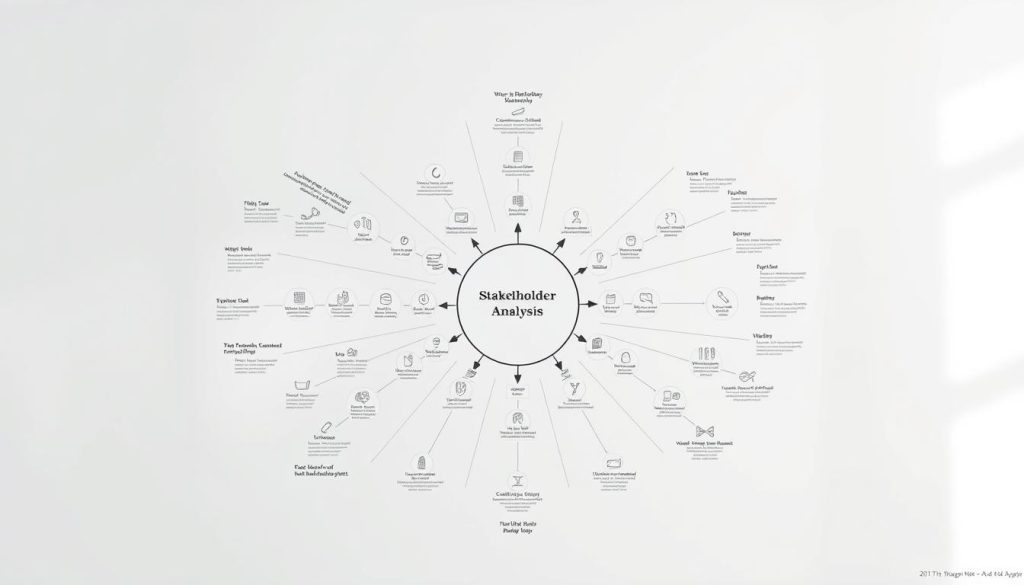In today’s interconnected world, building strong relationships with stakeholders has become essential for success. This guide explores practical approaches for creating meaningful connections that benefit both organizations and the people they serve.
Effective collaboration helps groups make better decisions and build lasting trust. When organizations listen to stakeholder voices, they create sustainable positive impacts.
Leaders across various sectors can discover actionable frameworks in this comprehensive resource. From government agencies to corporate teams and educational institutions, everyone can benefit from these proven methods.
The strategies covered range from basic concepts to advanced digital tools. Real-world examples demonstrate how successful initiatives create mutual value through transparent, reciprocal partnerships.
Table of Contents
Key Takeaways
- Building strong stakeholder relationships drives organizational success
- Effective collaboration leads to better decision-making processes
- Trust develops through consistent, transparent interactions
- Various sectors can apply these principles for positive impact
- Digital tools enhance traditional connection methods
- Successful initiatives create value for all participants
- Proven frameworks help navigate relationship complexities
Understanding Community Engagement
Organizations seeking meaningful impact must first grasp the fundamentals of how people connect and collaborate. This foundation begins with clear definitions of key terms and their historical context.
Defining Key Terms and Concepts
Community engagement represents a dynamic process where organizations work with populations sharing geographic or interest-based connections. The United Nations describes it as « a strategic process to directly involve local populations in all aspects of decision-making. »
This practice focuses on mutual knowledge exchange and resource sharing. Understanding terminology helps leaders navigate different approaches effectively.
Historical Evolution and Context
The concept’s roots trace back to social justice movements. Saul Alinsky’s work in the 1930s-1940s established early frameworks for organized action.
Key developments shaped modern practice:
- 1974: Community Development Block Grant Program mandated public input
- 1993: National and Community Service Trust Act created AmeriCorps
- Early 2000s: Digital platforms expanded reach beyond physical boundaries
- Late 2000s: Corporate Social Responsibility became standard business practice
These milestones demonstrate how the approach evolved from grassroots efforts to structured organizational practice across sectors.
The Importance of Community Engagement for Organizations and Leaders
The practice of involving local voices in organizational processes yields concrete advantages that enhance decision-making and build lasting credibility. These benefits extend far beyond simple public relations, delivering tangible value that strengthens operations and social standing.

Building Trust and Social Responsibility
Transparent communication creates foundations of trust that demonstrate organizational accountability. This approach fosters stronger relationships with surrounding populations.
Organizations gain awareness of social, environmental, and economic factors influencing their operations. This knowledge supports more responsible practices that consider stakeholder well-being.
Driving Better Decision-Making
Access to diverse perspectives provides valuable insights that improve organizational decisions. This comprehensive understanding helps leaders consider the bigger picture.
When communities participate in processes affecting them, policies become more practical and sustainable. The resulting impact aligns with actual needs rather than assumptions.
These collaborative approaches create mutual benefits that support long-term success. Organizations secure informal acceptance through genuine partnership rather than imposed presence.
Crafting a Community Engagement Strategy
Successful relationship-building with local populations demands a structured methodology that balances immediate needs with future vision. This systematic approach requires careful planning and clear objectives from the outset.
A well-crafted strategy begins with identifying key stakeholders and defining measurable outcomes. Organizations must consider both current projects and future initiatives when developing their comprehensive plan.
Setting SMART Objectives
The SMART framework provides essential guidance for goal-setting. Objectives should be Specific, Measurable, Achievable, Relevant, and Time-bound.
This approach ensures clarity and trackable progress. Each objective must align with broader organizational goals while addressing stakeholder needs.
Developing a Long-Term Engagement Plan
Strategic planning extends beyond immediate project requirements. Organizations should build sustainable relationships that withstand changing circumstances.
Long-term thinking helps avoid common pitfalls and maintains consistency. This forward-looking approach creates lasting credibility and mutual benefits for all involved parties.
Building Effective Communication Channels
Effective dialogue mechanisms serve as the backbone for successful organizational-stakeholder interactions. These systems enable continuous information exchange and relationship development.
Facilitating Two-Way Conversations
Moving beyond simple information distribution requires creating genuine dialogue opportunities. Organizations should encourage community members to share perspectives and provide meaningful feedback.
Each interaction builds trust and yields valuable insights for decision-making. Quick responses and consistent follow-up demonstrate genuine commitment to this engagement process.

Utilizing Local and Digital Platforms
Meeting people where they already gather ensures accessibility and comfort. Essential platforms include social media for digital audiences and local events for personal connections.
Schools, libraries, and shopping centers serve as natural gathering points. Traditional channels like email and phone remain vital for comprehensive outreach.
Regular evaluation ensures these communication methods remain effective for diverse populations. This approach supports meaningful participation in organizational activities.
Engaging Community Members Through Inclusive Practices
Creating environments where every voice matters requires deliberate strategies that welcome diverse perspectives. Organizations achieve meaningful participation by removing barriers and building trust with local populations.
Successful initiatives demonstrate active involvement from various stakeholder groups. This participation serves as a key indicator of effective relationship-building efforts.
Encouraging Participation and Feedback
Organizations should clearly communicate their desire for member involvement. Promoting the benefits of partnership motivates greater participation across different segments.
Making opportunities accessible ensures all voices contribute to decision-making processes. This approach creates more equitable outcomes that reflect comprehensive understanding of local needs.
Inclusive practices foster social equity by ensuring marginalized groups have equal opportunities. The resulting policies and programs become more responsive to actual community challenges.
When members feel valued and heard, social cohesion strengthens. This leads to sustainable outcomes with collective ownership from diverse populations.
Tools and Techniques for Community Engagement
Modern organizations require specialized resources to manage stakeholder relationships effectively. Various digital solutions and traditional methods provide comprehensive approaches for meaningful connections.

Leveraging Stakeholder Management Software
Specialized software like Simply Stakeholders offers powerful tools for tracking interactions and analyzing data. These platforms help organizations maintain detailed records of stakeholder preferences and history.
The United States Department of Energy uses this software to manage subject matter experts. They organize professionals by expertise, location, and characteristics for efficient grant evaluation.
Beyond software, effective techniques include surveys, focus groups, and public forums. Digital platforms expand reach while traditional methods maintain personal connection.
Organizations should evaluate which resource options align with their specific goals. Combining data-driven insights with human interaction creates the most impactful approaches.
Case Studies and Practical Examples
Practical case studies offer valuable insights into how different entities navigate the complexities of public involvement processes. These real-world examples demonstrate successful implementation across various sectors.
Government Engagement Initiatives
Government organizations often face unique challenges when launching public participation initiatives. Bureaucratic complexity and resource limitations can hinder effective implementation.
The United States Department of Energy exemplifies successful adaptation. They use specialized software to manage independent subject matter experts for grant evaluation programs.
This approach organizes professionals by expertise and location. It ensures appropriate matching for specific evaluation projects.
Sustainable Development Projects
Sustainable development projects benefit significantly from early stakeholder involvement. Beginning participation during planning stages creates stronger alignment with local needs.
Agricultural-focused initiatives in rural libraries demonstrate mutual benefits. Farmers’ markets and community gardens serve multiple purposes while building valuable connections.
These programs generate networking opportunities and skill building. They represent effective community engagement models that organizations can adapt.
Stakeholder Analysis and Relationship Building
Systematic stakeholder analysis provides the essential groundwork for building meaningful organizational connections. This process helps identify key groups and individuals who impact or are impacted by your initiatives.

The methodology involves five crucial steps that form a continuous cycle. Organizations must first identify all relevant parties, then assess their interests and influence levels.
Mapping Stakeholder Influence
Effective mapping reveals power structures and alliance patterns within your community. This visual approach helps prioritize engagement efforts based on strategic importance.
| Analysis Tool | Primary Function | Best Use Case | Key Benefit |
|---|---|---|---|
| Interest-Influence Grid | Categorizes stakeholders by power and interest | Initial prioritization | Quick visual assessment |
| Social Network Analysis | Maps relationship connections | Identifying influencers | Reveals hidden alliances |
| Stakeholder Maps | Visual representation of relationships | Team alignment | Clear communication tool |
| SWOT Analysis | Evaluates engagement strengths/weaknesses | Strategic planning | Comprehensive risk assessment |
Quality data collection ensures accurate mapping results. Organizations should gather information about each stakeholder’s expectations and potential contributions.
Establishing Lasting Community Relationships
Building sustainable relationships requires moving beyond transactional interactions. Consistent communication and demonstrated commitment create genuine connections.
« Stakeholder analysis isn’t about manipulation—it’s about understanding perspectives to build mutually beneficial partnerships. »
Strong relationships encourage community members to consider organizational viewpoints. This trust develops through reliable, transparent interactions over time.
Organizations that invest in systematic stakeholder analysis create foundations for successful collaboration. For deeper insights into improving these processes, explore this comprehensive guide to stakeholder engagement.
Tracking stakeholder details through data systems maintains institutional memory. This ensures consistent, personalized engagement despite staff or circumstance changes.
Overcoming Challenges in Community Engagement
Organizations often face significant hurdles when implementing public participation initiatives. These obstacles range from limited resources to cultural differences that affect participation rates. Recognizing these challenges represents the first step toward developing effective solutions.
Identifying Common Barriers
Government entities particularly struggle with bureaucratic complexity and outdated systems. Many find it difficult to launch new initiatives or sustain participation over time.
Smaller organizations face resource limitations that restrict their approach. Comprehensive frameworks like Collective Impact demand substantial commitments that may exceed available capacity.
Cultural and social differences create additional barriers to full involvement. Language differences, historical distrust, and accessibility needs can limit participation if not properly addressed.
Implementing Adaptive Solutions
Successful organizations combine multiple strategies to overcome these challenges. They update knowledge through training and adopt appropriate technology tools.
Building organizational capacity helps sustain efforts over time. This includes staff development, leadership commitment, and adequate resource allocation.
The most effective approach treats public involvement as an ongoing learning process. Organizations remain open to feedback and adjust their methods based on evolving circumstances.
Leveraging Digital and Social Media for Public Participation
Technology has fundamentally reshaped the dynamics of organizational-public relationships, creating innovative pathways for collaboration. The internet’s emergence transformed traditional approaches, enabling real-time global interactions that transcend geographical limitations.
Innovative Online Engagement Methods
Digital platforms offer diverse methods for meaningful public participation. Virtual town halls, interactive webinars, and online surveys provide accessible options for diverse populations. These digital tools reduce barriers for people with mobility or scheduling constraints.
Social media campaigns and crowdsourcing initiatives demonstrate the power of online collaboration. Movements like #BlackLivesMatter showed how digital platforms can drive significant social change. Organizations must establish presence where people already gather online.
Effective digital strategies combine multiple methods for comprehensive outreach. To enhance your social media engagement with proven, focus on authentic communication and rapid response capabilities.
Multi-channel approaches ensure technology complements rather than replaces personal interaction. This balanced strategy supports meaningful public participation across all demographic groups.
Conclusion
Genuine stakeholder involvement transforms organizational effectiveness by creating shared value and sustainable outcomes. This strategic approach moves beyond simple consultation to build meaningful partnerships.
Organizations that prioritize these practices gain valuable insights and build lasting trust. They make better decisions informed by diverse perspectives. This leads to initiatives that truly address local needs.
The future will bring new digital tools, but core principles remain constant. Success requires dedicated resources, staff training, and adequate planning time. For deeper guidance, explore this comprehensive approach to stakeholder relationships.
Authentic participation creates stronger outcomes for all involved. It represents an ongoing journey of learning and adaptation that yields meaningful impact.
FAQ
What are the primary benefits of developing a robust strategy for involving local groups?
A well-defined approach helps organizations build trust, gain valuable insights, and make more informed decisions. It strengthens social responsibility and ensures that initiatives are aligned with the actual needs of the people they aim to serve.
How can organizations effectively encourage participation from diverse members?
Implementing inclusive practices is key. This involves creating accessible events, using multiple communication platforms, and actively soliciting feedback. Ensuring that all voices are heard and valued fosters a greater sense of ownership and involvement.
What role do digital tools play in modern public participation efforts?
Digital platforms, including social media and specialized software, are essential for facilitating two-way conversations. They allow for broader reach, real-time feedback, and innovative methods like online forums and virtual town halls, making involvement more convenient for many individuals.
What are common barriers faced during these initiatives, and how can they be addressed?
Typical challenges include limited resources, stakeholder apathy, and communication gaps. Overcoming these requires careful planning, adaptive solutions like flexible meeting times, and transparent communication to build lasting relationships and demonstrate the tangible impact of contributions.
Why is stakeholder analysis a critical step in the planning process?
Analyzing stakeholders helps identify key groups, understand their influence, and tailor outreach strategies. This ensures that efforts are focused effectively, resources are allocated wisely, and stronger, more meaningful connections are established from the outset of a project.





